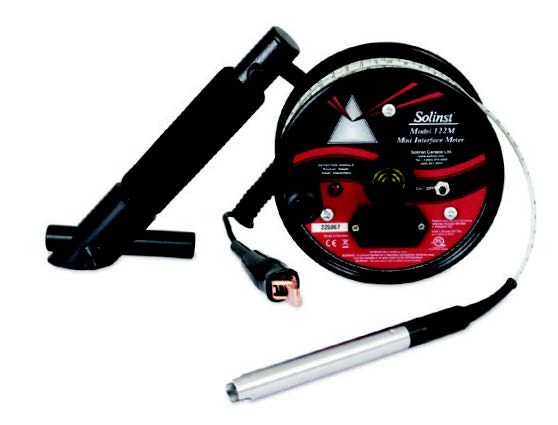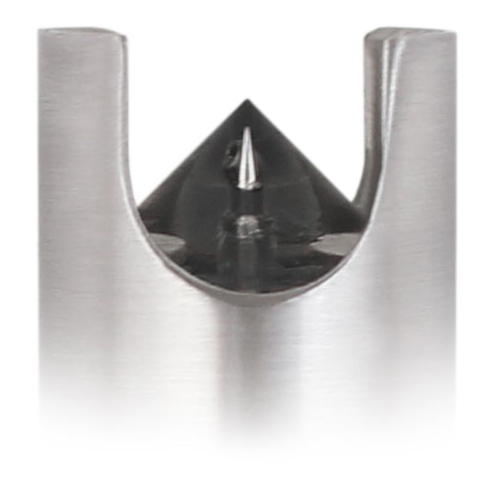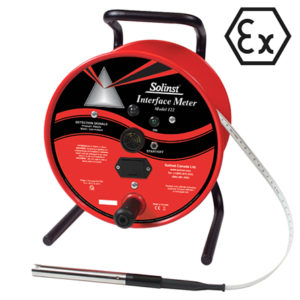Description
Características
- Sensor accuracy at 1.0mm.
- Certified intrinsic safety.
- 16 mm diameter probe.
- Easy access battery with a minimum of 300 hours of useful life.
- Electronic devices with automatic circuit tests.
- Compact and easy to transport.
- Designed for rugged field use.
The 122M interface probe provides clear and precise measurements of product level and thickness in wells and tanks. Determination of non-aqueous phase (LNAPL) lightweight (floating) and non-aqueous phase dense (sinking) liquids (DNAPL) is quick and easy.
The Model 122M Mini Interface Meter with Laser Marked Cable is a small, convenient version that can easily fit in an optional backpack or small carrying case. Use a narrow laser marked cable, in lengths of 25m.
The improved electronic devices of the mini interface meter include automatic circuit tests, battery life of 300 hours, clear signals and high precision. The circuits are powered by a standard 9V battery, located in an easily accessible tray on the front plate.
Probe
The 122M probe uses the P8 electrode, has a diameter of 16 mm and is made of stainless steel. Resists pressure up to 500 psi. The beam is emitted from a Hydex cone shaped tip. The tip is protected by an integral stainless-steel shield and is excellent for the vast majority of product monitoring situations. A cleaning brush is included with each probe
Laser marked cable
- The cable is traceable to NIST and EU measurement standards.
- The 3mm coaxial cable is jacketed with permanent laser markings every millimetre. The cable has a stranded copper outer conductor, a stranded stainless steel centre conductor, and a smooth, chemical-resistant surface that is easy to clean.
- LN3: meters and centimetres, with marks every millimetre.
Funcionamiento
Product (non-conductive liquid) = constant light and tone
Water (conductive liquid) = flashing light and tone
To detect liquids, the 122M interface probe uses an infrared light beam and detector. When the electrode enters a liquid, the beam is refracted away from the detector that activates a sound signal and a light. If the liquid is non-conductive, the signal is constant. If the liquid is conductive (water), the conductivity of the water completes the conductivity circuit. This overrides the infrared circuit, and the signal and light are intermittent.
The sensors have exactly the same zero point, providing good accuracy up to 1.0mm. The high precision allows sensors to detect the slightest trace of oil on the surface of the water.
Use in potentially explosive places
The 122M wired interface probe is QPS approved for use in hazardous locations, Class I, Div. 1, Groups C and D according to CSA standards. It is also certified by ATEX according to directive 94/9 / EC, as II 3 G Ex ic IIB T4 Gc.
The ground wire is an essential safety element when using the probe in potentially explosive environments. It also ensures that electronic devices are adequately protected.
FAQ
Troubleshooting
When the instrument is turned on you will see a steady red light (no audible alarm).
- Indicates there is a connection problem. Contact Envirotecnics for more information on how to resolve the problem.
The instrument does not turn on (there is no start tone)
- Replace the battery.
- Check the polarity of the battery in the compartment: make sure that the + and – symbol on the battery and in the compartment match. The electrode can be damaged by an inverted battery.
- The ON / OFF button may be faulty. Contact Envirotecnics.
When the instrument is turned on, it immediately emits the hydrocarbon tone or the intermittent water tone.
- The probe sensor may be dirty. Clean it according to cleaning and maintenance instructions.
- Water has been able to seep into the electrode. Stir it carefully, keeping the cables connected. Dry and clean it, and inspect the o-ring (o-ring), replace if necessary and / or lubricate with silicone. To avoid cuts or damage to the cables, make sure they are tucked inside the probe body when you are ready to replace it. See probe replacement instructions.
- The tape may be damaged. Clean the tape and watch for cuts or damage. If necessary, replace the tape. To maintain Intrinsic Safety Certification 122, do not make splices or repairs to the tape. Contact Envirotecnics for assistance.
- The reel or probe circuits may be damaged. Contact Envirotecnics.
The instrument does not detect liquids
- Check the battery. Replace it if necessary.
- Clean the electrode tip following the cleaning and maintenance instructions.
- The electrode may be damaged. Contact Envirotecnics.
The instrument detects “hydrocarbon” as “water”
- Note that this can happen if the electrode enters the hydrocarbon too quickly and therefore draws water with it. Thoroughly dry the tip or shake it gently and try again more slowly.
- The hydrocarbon may have been degraded or is now altered enough to become an emulsion. If you have a detectable level of conductivity, it will read water. Wait for it to stabilize and try again.
The instrument does not detect water
- Clean the tip of the electrode. Follow cleaning and operating instructions.
- The water may be pure and non-conductive, or the hydrocarbon may coat the probe, in which case, briefly shake it in the water column to remove the hydrocarbon.
- The probe circuits could be damaged due to high (static) voltage in the well. Always use the ground pole. Contact Envirotecnics.





